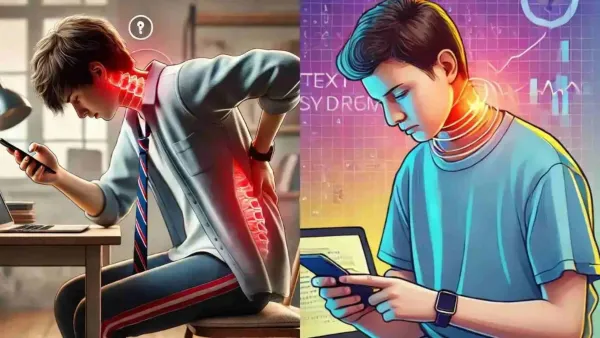JD Vance Visits Amer Fort And Hawa Mahal In Jaipur With Family; What Makes The Two Monuments So Iconic?

If you’re a fan of The White Lotusyou’ve probably dreamed about a wellness escape as luxurious as the show’s fictional Thai retreat. Picture this: daily yoga sessions, deep-tissue massages, meditation, biometric scans, and maybe even a float in a sensory deprivation tank. But what about a full-blown digital detox? No phones, no tablets, no screens at all.
Tempting as it sounds, completely unplugging is a fantasy for most of us. In today’s screen-obsessed world, a tech-free life seems almost impossible. From work to entertainment to staying connected, we’re glued to our devices. And it’s starting to take a visible toll—on our bodies.
Tech Neck: The Posture Problem You Didn’t Know You Had
Dr. Karishma Sanghavi, a sports physiotherapist and certified MDT specialist, says we may already be in the early stages of a “posture epidemic.”
“With access to technology not just for work, but for leisure, socialising, and entertainment, we are looking at our screens for almost 8–12 hours per day, often in slouched and static positions,” she explains. “We’re seeing people in their 20s and 30s with chronic pain.”
She adds that the post-COVID shift to work-from-home life hasn’t helped. Many people now work from their beds or couches—hardly ergonomic setups. The result? Poor posture is becoming widespread at an alarmingly young age.
What Exactly Is Tech Neck Doing to You?
The term “tech neck” describes the strain caused by looking down at screens for extended periods. One of its most noticeable consequences is the development of a Dowager’s hump—an exaggerated curve of the upper back once mostly associated with older adults. Now, it’s showing up in young people far too often.
And it’s not just about how you look.
“Poor posture can trigger a cascade of issues,” says Dr. Sanghavi. These range from spinal misalignments and poor balance to a decrease in lung capacity and even negative effects on mental health.
“When you hunch forward, your chest and lungs collapse slightly, which reduces oxygen intake,” she explains. “It also slows the cerebrospinal fluid (CSF) that circulates around the brain and spinal cord, potentially affecting brain waste clearance and leading to brain fog or fatigue.”
Another concern? The vagus nerve, which helps calm the body. A hunched posture can compress this vital nerve, leading to heightened stress, emotional imbalance, and increased anxiety.
How Your Devices Are Changing Your Hands
Our obsession with our phones isn’t just affecting our backs and necks—it’s also showing up in our hands and arms.
Take selfie elbowfor example. Yes, it’s a real thing. Holding your arm out to snap countless selfies can inflame your tendons, especially if your elbow stays extended or twisted.
Then there’s text clawa term that describes the pain from overusing your fingers and thumbs to scroll, swipe, and type.
Dr. Ashis Acharya, Senior Consultant for Orthopaedics and Sports Medicine at Sir Ganga Ram Hospital, says that while “text claw” isn’t an official medical diagnosis, the symptoms are very real. “Long periods of fine motor activities can cause tendon degeneration, nerve irritation, and even locked fingers,” he says.
His advice? “Gentle hand and wrist exercises, switching to a stylus or voice input, and taking regular breaks can help reverse or avoid these issues.”
More Than Just Sore Muscles: The Full Impact of Tech Overuse
Dr. Anup Khatri, a Senior Consultant Orthopaedist at Gleneagles Hospital, says the effects of tech overuse don’t stop at your hands and spine.
“Excessive screen use can lead to eye strain, jaw pain, teeth grinding, changes in skull structure, and even altered facial muscle tone,” he warns. Common early symptoms like neck stiffness, headaches, and upper back discomfort shouldn’t be ignored.
Fortunately, new tools are helping people be more mindful of their posture. “Smart posture wearables, ergonomic furniture, and posture tracking apps offer real promise in preventing long-term damage,” says Dr. Khatri.
Tiny Changes, Big Results: How to Build Better Habits
If you’re worried you’re already on the tech neck track, the good news is that small, consistent changes can make a huge difference.
Dr. Sanghavi suggests following the 20-20-20 rule:
Every 20 minutes, move 20 feet away from your screen and rest your hands for 20 seconds.
This quick break is a good time to do simple stretches or mobility movements to ease muscle tension.
She also shares a quick, five-minute daily routine to help reset your posture and reduce screen- strain:
Your 5-Minute Anti-Tech Neck Routine
-
Chin tucks: 10 reps (30 seconds)
-
Upper back rotations: 10 reps (1 minute)
-
Cat and camel stretches: 10 reps (1 minute)
-
Shoulder blade squeezes: 10 reps with a 5–10 second hold (1 minute)
-
Full arm stretches: Stretch each arm forward, elbows straight, wrist pulled back (30 seconds each side)
-
Wrist rotations and gripping exercises: (30 seconds)
We might not be able to sign up for a fictional wellness retreat, but we can take better care of our bodies in the real world. As tempting as it is to stay glued to your screen, the price of convenience is often poor posture, nagging pain, and long-term physical strain.
A few mindful changes—like stretching, taking breaks, and setting up a proper workstation—can go a long way in keeping you healthy, grounded, and maybe even a little less stressed. After all, the best kind of detox might just start with better posture.
-
Why can't India produce footballers like it does cricketers?

-
Border fire draws in digital war, tourists looking for quick bucks

-
Dream11 parent to invest $50 million in Times Internet’s Cricbuzz and Willow TV

-
Renesas-CG Power venture likely to roll out first chip by mid-2026, says Hidetoshi Shibata

-
Tata 1mg plans more offline forays as it looks to raise $300 million
